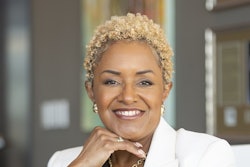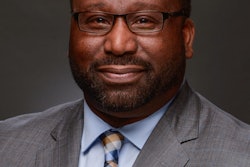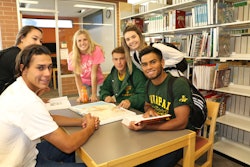Foreign language courses are booming on American college campuses, a new study finds, with enrollment in Arabic more than doubling from 2002 to 2006.
The latest figures from the Modern Language Association of America, released Tuesday, reflect a major push toward internationalization on college campuses, more government support for language study and simply more interest from students. Over four years, total enrollment in language courses has grown 12.9 percent.
Spanish remains the most popular subject, with more than 823,000 students enrolled, up 10.3 percent since 2002 and nearly four times higher than No. 2 French.
But Arabic is the fastest-growing major language, breaking the top 10 for the first time with just under 24,000 enrollments, compared to about 10,600 in 2002. The number of institutions offering Arabic has nearly doubled to 466, including both two- and four-year colleges.
Between 2002 and 2006, Arabic enrollment jumped from 222 to 482 at Georgetown University, from 37 to 156 at Boston College and from 65 to 184 at Arizona State.
Enrollments in languages such as Russian and Arabic have traditionally spiked with world events, but Dr. Karin Ryding of the MLA and a professor of Arabic at Georgetown said she thinks these increases will stick.
“Young people today understand that the world is truly and inevitably smaller, and they’re coming to the study of Arabic with serious, professional goals in mind,” she said.
More than 200 less-common languages everything from Nepali to Macedonian to Native American languages like Crow and Blackfeet are now taught on college campuses. Enrollment in those courses is up one-third in the four years that the MLA studied.
More traditional languages, while growing at slower rates, have held their own. Overall, foreign language enrollment (excluding Latin and ancient Greek) stands at about 1.5 million, or about two-and-a-half times higher than in 1960.
Besides growing interest in global affairs, the MLA and other experts point to several factors. Many schools have reinstated language requirements after dropping them during the 1960s and ’70s. More students are also arriving with a head start from high school.
Emily Pollokoff, a student at Emory University in Atlanta, is typical of the new generation of language learners. The sophomore from Chicago is in her first year of Arabic and second year of Hindi, and plans to start Sanskrit next year.
“My interest in language comes from just wanting to understand people better,” she said. “There are so many ways to connect with people — music, food, smiling. But language, being a specifically human phenomenon, makes so much possible.”
Pollokoff said her Hindi class is full. Some students have Indian or Arab heritage and want to connect with their own cultures and families. Others have no ethnic tie but are studying subjects ranging from business to politics to environmental studies and believe they’ll need language skills to succeed.
Colleges are offering more kinds of instruction. Dan Bayer, executive director of the language center at the University of Southern California, said that after introductory courses students there used to have few options besides literature courses.
But many “are not really interested in reading Moliere,” he said. Now USC has developed other options — medical Spanish, Chinese for business.
The study does not directly measure how well students are learning, but it does differentiate between beginning and advanced classes. In Arabic, it found just 11 percent of all enrollments were in advanced courses, compared to 25 percent in Portuguese and 27 percent in Russian.
One reason for the gap is likely that colleges are struggling to attract instructors.
“There’s a dearth of really highly trained people to teach Arabic,” said Dr. Paula Debnar, acting associate dean of faculty at Mount Holyoke, a women’s college in Massachusetts. “This is such a change from five years ago when you’d just have students studying Spanish and French.”
Mt. Holyoke is trying to work with other area colleges to create shared teaching positions in Japanese and Arabic. In recent years, it’s hired three new Spanish professors, one in Italian and a new Chinese instructor.
Elizabeth Dumont-McCaffrey, a Mount Holyoke sophomore, sat in on an Arabic class while visiting campus in high school. When she arrived, she talked to her parents and agreed it would be a good subject to take.
“I absolutely love it. It’s my favorite class,” she said. “I just love being able to watch Al-Jazeera and be able to hear the different perspectives.”
Other languages with major enrollment jumps since 2002 were Chinese, in which enrollment rose 51 percent to about 51,600, and American Sign Language, which is now the fourth-most studied foreign language with about 79,000 students, up 30 percent over four years.
–Associated Press
There are currently 0 comments on this story.
Click here to post a comment
© Copyright 2005 by DiverseEducation.com


















